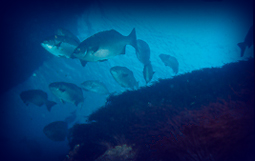Marine larval dispersal and connectivity
The offspring of most coastal marine organisms develop in offshore waters for extensive periods of time and potentially travel large distances before returning to near-shore habitats. The extent to which offspring are “lost” from their parental populations and successfully “captured” by more distant populations is a measure of population connectivity. Population connectivity underpins the population dynamics and evolution of most marine species, determines the efficacy of marine reserves, and influences the response of natural systems to perturbations including pollution, invasive species, climatic anomalies, and fishing.
We have pioneered the use of “environmental fingerprints” (i.e., chemical signatures) and daily growth records contained within the otoliths (i.e., “ear bones”) of fish, as markers of their developmental histories and geographic origins. These approaches enable us to infer patterns of movement, growth, and survival of young fishes—that would otherwise remain entirely hidden from view.
In applying these approaches to a range of model species (e.g., common triplefin, inanga, sixbar wrasse), we have discovered that developmental histories shape phenotypes and fitness of fish (e.g., Shima and Swearer 2009, 2010), and that the resulting demographic heterogeneity drives population dynamics (Noonburg et al. 2015, Shima et al. 2015).
Our ongoing work continues to explore the consequences of dispersal and developmental histories on behaviour and demographic rates later in life (i.e., “carry-over effects”).
Key Collaborators
Steve Swearer – University of Melbourne
Erik Noonburg – Independent Researcher
For more information, see:
Research publications
Swearer, S.E., J.S. Shima, M.E. Hellberg, S.R. Thorrold, G.P. Jones, D.R Robertson, S.G. Morgan, K.A. Selkoe, G.M. Ruiz, R.R. Warner. (2002). Evidence of self-recruitment in demersal marine populations. Bulletin of Marine Science 70:251-271.
Shima, J.S. and S.E. Swearer (2009) Larval quality is shaped by matrix effects: implications for connectivity in a marine metapopulation. Ecology 90:1255-1267
Shima, J.S. and S.E. Swearer (2009). Spatially variable larval histories may shape recruitment rates of a temperate reef fish. Marine Ecology Progress Series 394:223-229.
Shima, J.S. and S.E. Swearer (2010) The legacy of dispersal: larval experience shapes persistence later in the life of a reef fish. Journal of Animal Ecology 79:1308-1314
Swearer, S.E. and J.S. Shima. (2010) Regional variation in larval retention and dispersal drives recruitment patterns in a temperate reef fish. Marine Ecology Progress Series 417:229-236.
Shima, J.S., E.G. Noonburg, and N.E. Phillips. (2010) Larval dispersal in spatially structured coastal environments; life history and matrix heterogeneity interact to shape connectivity in marine metapopulations. Ecology 91:1215-1224.
Neubauer, P., J.S. Shima, S.E. Swearer. (2010) Scale-dependent variability in hatchling otolith chemistry: implications and solutions for studies of population connectivity. Marine Ecology Progress Series 415:263-274.
Neubauer, P, J.S. Shima, and S.E. Swearer. (2013) Inferring dispersal and migrations from incomplete geochemical baselines: analysis of population structure using Bayesian infinite mixture models. Methods in Ecology and Evolution 4: 836-845
Noonburg, E.G., A. Chen, J.S. Shima, and S.E. Swearer (2015) Demographic heterogeneity and the dynamics of open populations. Ecology 96:1159-1165.
Shima, J.S., E.G. Noonburg, and S.E. Swearer (2015) Consequences of variable larval dispersal pathways and resulting phenotypic mixtures to the dynamics of marine metapopulations. Biology Letters 11:20140778.
J.S. and S.E. Swearer (2016) Evidence and population consequences of shared larval dispersal histories in a marine fish. Ecology 97: 1373–1380.
Caie P. and J. S. Shima (2019) Patterns of selective predation change with ontogeny but not density in a marine fish. Oecologia 189: 123–132.
McNaughtan D and J.S. Shima.(2025) Spatial variation in the nearshore distribution and phenotypic traits of reef fish larvae suggest condition-dependent larval retention. Marine Ecology Progress Series 765: 73-84.
Data sets
Shima, J. S., Swearer, S. E. (2025) Data from: Larval developmental histories, phenotypes, and stage-specific fitness of a temperate reef fish. Dryad Digital Repository. link to data
Media coverage / popular articles
Radio New Zealand sound archives link to file
Video showing our sampling along Wellington's south coast: recovery of light traps (used to sample larval fish) and CTD data loggers (used to measure properties of water), benthic surveys, and a training dive on the frigate F-69.
|

